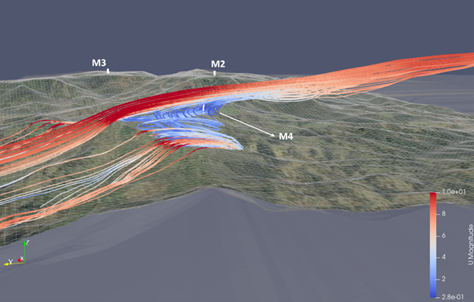Predicting wind flow and speed comes up against limitations in modern large-scale wind farms, or farms in somewhat complex environmental settings with features such as distant mountains, whether using microscale or mesoscale weather models. Laborelec is engaged in a project to test the potential of combining both these models to get better predictions of wind farm yields.
September 2024

The standard microscale wind flow and wake engineering models commonly used in the industry have proven their value for wind farms of limited size in relatively uncomplicated landscapes, where mesoscale features have limited impact. But in the very large modern wind farms or in smaller wind farms in close proximity to mountains or other sizeable topographical elements, larger-scale atmospheric conditions can have an impact down to turbine level. These conditions are not supported by the microscale models.
While mesoscale models — such as the weather research and forecasting (WRF) model — do take into account such phenomena, they are unable to produce results at the granular level necessary to successfully optimize site layout and operation.
Promising results with combined meso-microscale models
In 2023 and 2024, Laborelec tested the potential of combining micro- and mesomodels, in close collaboration with the von Karman Institute for Fluid Dynamics (VKI). Two distinct cases were studied. The first was an onshore wind farm where the complex topography was believed to be having a significant impact on wind flows and speed. The second was a wind farm off the coast of Scotland, where mesoscale modelling seemed appropriate given the size of the farm, interactions with nearby wind farms, and proximity to the coast.
In both cases, multiple meso- and microscale models were combined by using the outputs of the mesoscale models as inputs for the microscale models. These combined meso-micro caclulations were then compared to on-site measurements and to SCADA data. For onshore wind farms, the mesoscale and meso-micro coupling outperformed standard industry practice models. For offshore wind farms, a careful combination of mesoscale and wake models meant that production could be predicted with a low bias.
Laborelec expert Claude Abiven sees potential: “We identified highly promising combinations in both instances. We’ll be conducting further investigations in the coming months, exploring other models and additional sites with varying characteristics.”